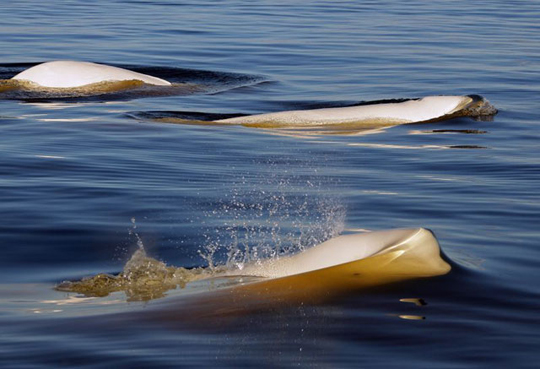Oceans North Canada, in partnership with Fisheries and Oceans Canada, will be back at Churchill Wild’s Seal River Heritage Lodge for a two-week period beginning July 3, 2013 for the second year of their three-year research study on the Hudson Bay population of beluga whales. They have 14 tags in total to deploy in both the Churchill and Seal rivers.
In our last update we mentioned that three tagged beluga whales had been successfully transmitting data back to the research team. Although full data analysis on habitat use by the beluga whales won’t start until the tagging project is complete, Oceans North Canada has learned a few things about beluga whale behavior so far:
- Belugas stayed close to the Seal river as expected throughout the months of July and August, with the highest density area near the mouth of the estuary
- Migration stated at the end of August/early September and all belugas still transmitting at the time of migration followed the western Hudson Bay coast closely and traveled around the north side of Southampton island
- Belugas arrived in what now appears to be their winter ground for this season in late November, which is similar timing to that of whales tagged in the Nelson estuary
- The winter range of the belugas is considerably further west than expected in the Hudson Strait
- Tagged bowhead whales from the Foxe Basin area are wintering in the same general area this year.
- Although they lost a few tags early on (could be many factors: battery, attachment, demise of whale), this is not unusual and two tags transmitting nine months after attachment is considered good (7.6 months was the longest tag from five years of beluga tagging work in the Nelson estuary)
Every summer, one of the largest concentrations of beluga whales in the world converges on southwest Hudson Bay as the sea ice recedes. This is one of the main reasons Churchill Wild began the offering the popular Birds, Bears & Belugas safari many years ago.
Thanks to you, our valued readers and guests, Birds, Bears & Belugas has now become one of the most popular wildlife adventure vacations in Canada, if not the world, and it is now part of the Canadian Tourism Commission’s Signature Experience Collection.
Birds, Bears & Belugas takes place during July and August and combines the thrill of swimming with beluga whales (as weather permits) with the Churchill Wild signature “on the ground” safari of summer polar bear viewing on a backdrop of tundra alive with flora and fauna!
Protecting Manitoba’s Beluga Estuaries
An estimated 57,000 belugas migrate to estuaries formed by the Seal, Nelson, and Churchill rivers every year. More scientific studies are needed to understand why belugas are drawn to these estuaries and how they interact with this environment so that key habitat can be protected. This research is also important to the hundreds of Inuit families in the area.
To learn more about this exciting and worthwhile study, please visit the Hudson Bay Beluga Project online, where you’ll find beluga whale facts, videos of the beluga whale tagging from Discovery Channel Canada, an interactive beluga tracking map and more!










